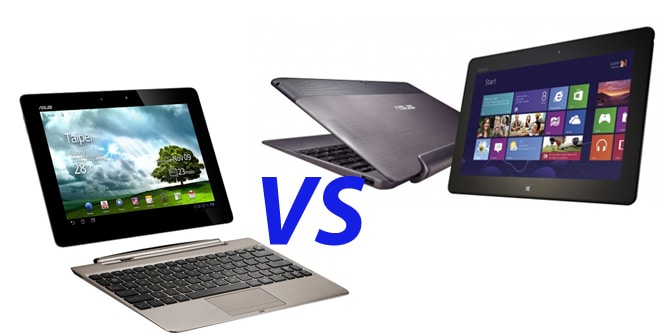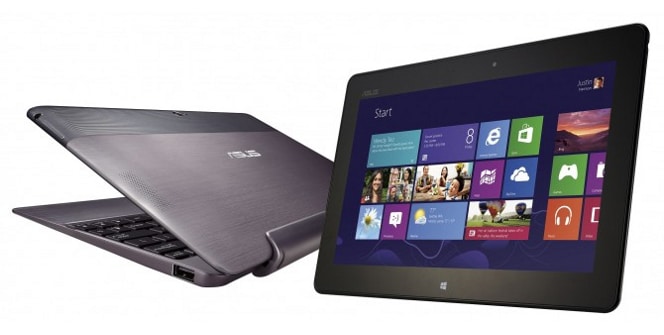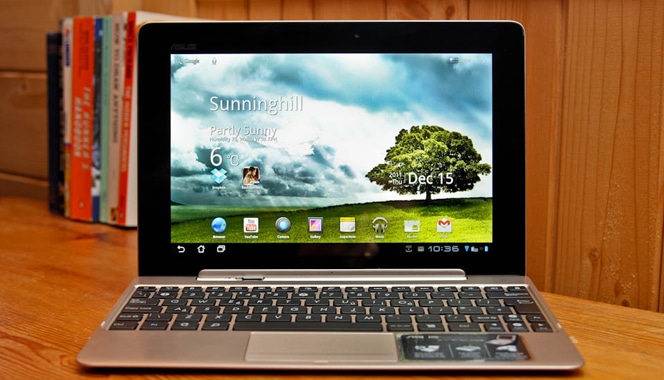
Today we want to offer you a perspective on how the Hybrid tablets with Android operating system and Windows 8 or Windows RT. To do this, we have chosen the king of Asus hybrid tablets and compared two models that will soon be in stores at the same time. For Android we choose the classic Asus Transformer Prime and for Windows 8, we chose the RT version, from Asus Vivo Tab RT.

We chose the version with Windows RT for several reasons, because it has a better chance of being in the price line of Android tablets, because it mounts ARM processors like the Android ones and because they have an identical size screen.
Hybrid tablets have been a bet that has had Android from the beginning and Microsoft later. Neither Apple nor Amazon have shown interest in highlighting this function of tablets as a work tool. These two models are true to that spirit.
Screen

Both have a 10,1 inchHowever, Asus Vivo Tab RT has a resolution of 1366 x 768 pixels with an IPS panel compared to the 1280 x 800 pixels and Super IPS + panel of Asus Transformer Prime. The result is similar in ppi definition, but the Transformer Prime panel is slightly better.
Size and weight
They will be almost the same, with 8,3mm thick without keyboard and something superior with keyboard. Of the Transformer Prime we do know the measurements, but of the Vivo Tab RT we do not, although I do not think they differ anything or almost nothing from its 21 mm thickness. In the weight, small differences are noticed. The Android version is a bit heavier, just 66 grams, that is, 520 grams from Vivo Tab RT by 586 from Transformer Prime. We do not know the weight of the keyboard dock of the Windows tablet but it should not differ much from the 537 grams of the dock of the Android.

Performance
Both tablets come equipped with a processor Quad-core Nvidia Tegra 3. The Transformer Prime has 1,3 GHz of power in each core that gives us a reference and is that we do not know the exact power of the Vivo Tab RT, but we already know that this processor can reach 1,7GHz or even 2,0 GHz if overlocked like Nexus 7. The GPU of the Asus Vivo Tab RT and Transformer Prime is practically the same. The RAM of the Windows RT tablet is higher, specifically twice, with 2 GB of RAM. This in principle should potentially give it superior performance, greater data management capabilities.
Regarding the operating system, at the moment, we cannot say much about the Windows 8 user experience, but in October we will have doubts. We know however that Windows RT tablet will feature vital applications such as Microsoft Office as standard. Android for its part always has heterodox solutions for these shortcomings.
Storage
The Windows RT model unveiled at IFA Berlin came with 32GB, the minimum we'd expect. Transformer Prime gives the option of 32 or 64 GB and expansion by SD, in addition to unlimited storage for the first year in Asus Web Storage. You would expect something similar in Vivo Tab RT.
Accessories and ports
Thanks to keyboard-dock they will have very similar capabilities. The QWERTY keyboard, the ports Additional USB y extra battery. Although, it is said that the Vivo Tab RT will have an NFC port. It would be crazy if the Windows RT version did not carry the SD slot and HDMI output from its Android cousin. We discard this option as crazy.
Price and conclusions
Transformer Prime worth 480 euros without dock and 580 with dock. Vivo Tab RT should never exceed these prices if it wants to be competitive. If Windows RT is all that is expected of it, we will be facing a better equipped tablet in RAM, a great advantage, and with NFC capacity. Also, Asus has had more time to get the most out of the Tegra 3, as it already did with the Nexus 7 and Transformer Infinity.